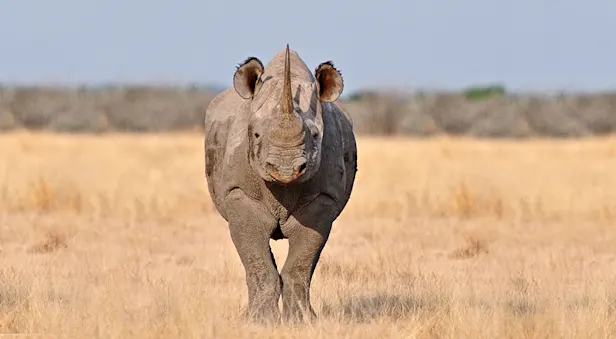Know Before You Go
Namibia Weather & Climate
Namibia is a land of sunshine, with an average of 300 sunny days a year. Winter (our summer) days are generally cloudless, with clear blue skies. In summer, clouds build up in late afternoon.
Many travelers assume that because they are traveling to Africa, it must always be warm. This is not the case during Namibia’s winter, however, particularly in May through September. You can expect days to be absolutely beautiful, temperate and sunny, but nights and early mornings will be chilly, possibly near freezing, so we recommend you bring warm layers you can peel off as it warms up through the day. A lightweight down jacket or fleece pullover is ideal. Gloves, hat, scarf and warm long pants are also essential at this time of year for early-morning wildlife drives.
Average Monthly Temperatures & Rainfall:
(In Fahrenheit and inches)
Windhoek

Sossusvlei

Please note that while average high temperatures in Sossusvlei for September through April are in the low to mid-90s, the region does experience higher temperatures, and it is possible for it to reach above 100° F.
Etosha National Park

Please keep in mind that these are averages, and that weather can be unpredictable. Be sure to check current weather conditions a few days before your departure at: www.weather.com. Remember to check the weather for each location on your itinerary, as conditions may vary.
Namibia Monthly Weather Information and Recommendations
January
January is the peak of summer, and although Namibia is a low-rainfall area, it is also the peak of the green season. Days are normally warm with afternoon cloud build-up and possible showers, although these are short-lived. Locations near the coast tend to be slightly cooler, and a cool wind often blows off the water in the afternoons. Be prepared for temperatures in the upper 80s or low 90s F in Sossusvlei and low 80s in Etosha and Okonjima—we suggest short-sleeved shirts, shorts or zip-off pants and plenty of protection from the sun. Temperatures in the Damaraland and Skeleton Coast areas will be cooler with highs in the mid-60s. For the brief periods of rain you will want a lightweight, “breathable,” waterproof rain jacket and rain pants. Nighttime temperatures are mild with lows in the 60s, so you will not need warm sleepwear.
February
Much like January, February is mid-summer in Namibia with warm, sunny days and short bursts of afternoon rain likely. Temperatures will depend on what part of Namibia you are visiting and will be very similar to those listed for January. Again, short-sleeved shirts, shorts or zip-off pants and plenty of protection from the sun are recommended, along with a lightweight, “breathable,” waterproof rain jacket and rain pants. Nighttime temperatures remain in the 60s F.
March
March is typically the wettest month of the year but still averages only 3.2 inches of precipitation. March brings the end of the green season, but you will still want to be prepared with a lightweight, “breathable,” waterproof rain jacket and rain pants. High and low temperatures are much the same as they are in January and February, with highs reaching into the 80s F in some areas (or possibly the low 90s F if you are visiting Sossusvlei) and lows in the 60s. Be prepared for warm, sunny days with T-shirts and shorts or zip-off pants.
April
April in Namibia becomes increasingly dry. The landscape is green, and the air is fresh and mostly free from dust. Although much less likely, rain is still a possibility in the afternoons. With the exception of Sossusvlei, temperatures start to cool down and will not exceed approximately 79 F. In Sossusvlei you should still be prepared for hot, sunny days in the low 90s. Also for Sossusvlei, short-sleeved shirts and shorts or zip-off pants are recommended. In other areas you may not need shorts. Low temperatures will still be mild and will most likely not drop below the mid- to upper 50s F.
May
In May, morning temperatures start to drop, and it tends to cool off soon after sunset. Afternoon rain showers are not likely, although a rainproof, windproof jacket will serve you well both to offer insulation from cooler temperatures in the evenings and early mornings, and in case there are any unseasonable rain showers. Lows will be in the 50s F, so you may also want a sweatshirt or fleece jacket to wear during cooler periods as well as a warm hat, gloves and a scarf. High temperatures will likely be in the mid- to upper 70s F, possibly as high as 90 F (with the exception of Sossusvlei where it may get into the mid-80s to low 90s F or higher).
June
Nighttime temperatures in June can drop below freezing in some desert areas. Travelers will experience pleasant daytime temperatures similar to those in May, so layering is key. You will want warm layers including a fleece, windproof jacket, warm hat, gloves and scarf for early morning hikes and drives, but you will need only lightweight clothing by the middle of the day (shorts may not be necessary, although zip-off pants are always a good idea).
July
July is very similar to June, as it is the middle of Namibia’s winter season. Travelers should be prepared for very chilly nighttime and early morning temperatures with a fleece, windproof jacket, warm hat, gloves and scarf. Once the days warm up, you will want to shed these outer layers and will need only lightweight under layers. During this time you can expect high temperatures in the 60s and low 70s F (possibly reaching the low 80s F in Sossusvlei). Lows will again have the potential to dip below freezing, although this is unlikely to happen every night.
August
August is slightly warmer than the previous several months, and temperatures below freezing are no longer very likely; however, it will still be cool at night and in the early mornings (usually in the low 50s F) so you will want a sweater or fleece. Daytime temperatures are warm, with highs in the 60s and 70s F, and it may be windy at times. Short-sleeved shirts and shorts or zip-off pants will be useful.
September
September is the end of the dry season, and temperatures can reach into the 90s F during the day and will typically be in the 50s F at night. Because there has been little or no rainfall for several months, it can be dusty this time of year. We again recommend layers and suggest you be prepared with a short-sleeved shirt, shorts or zip-off pants, plenty of sun protection (hat and sunscreen) and a bandana to cover your mouth and nose if it is dusty. A sweatshirt or fleece jacket may be welcome in the evenings and early mornings.
October
Winter is over, and warmer temperatures are starting to prevail. October is warm with temperatures ranging between the mid-50s F and low to mid-90s F. The green season is just beginning, so short bursts of afternoon showers are possible. We recommend layering with short-sleeved shirts, shorts or zip-off pants and plenty of protection from the sun during the day, as well as a lightweight, “breathable,” waterproof rain jacket and rain pants in case it rains in the afternoon.
November
In November the days are warm with temperatures in some areas reaching the mid-90s F. Evenings are also warm—temperatures do not drop much below the mid-50s F, so jackets and cold-weather gear are generally not necessary. Travelers should be prepared for short afternoon thunderstorms. A lightweight, “breathable,” waterproof rain jacket and rain pants are recommended.
December
In December, days may be slightly more humid than during the past several months, and travelers will experience warm, sunny days with temperatures reaching into the 90s F. Short-sleeved shirts, shorts or zip-off pants and a sun hat with a wide brim and plenty of sunscreen will be needed during the day. Afternoon showers are possible, and a lightweight, “breathable,” waterproof rain jacket and rain pants are again recommended.
Header Credit: Matt Kareus


























